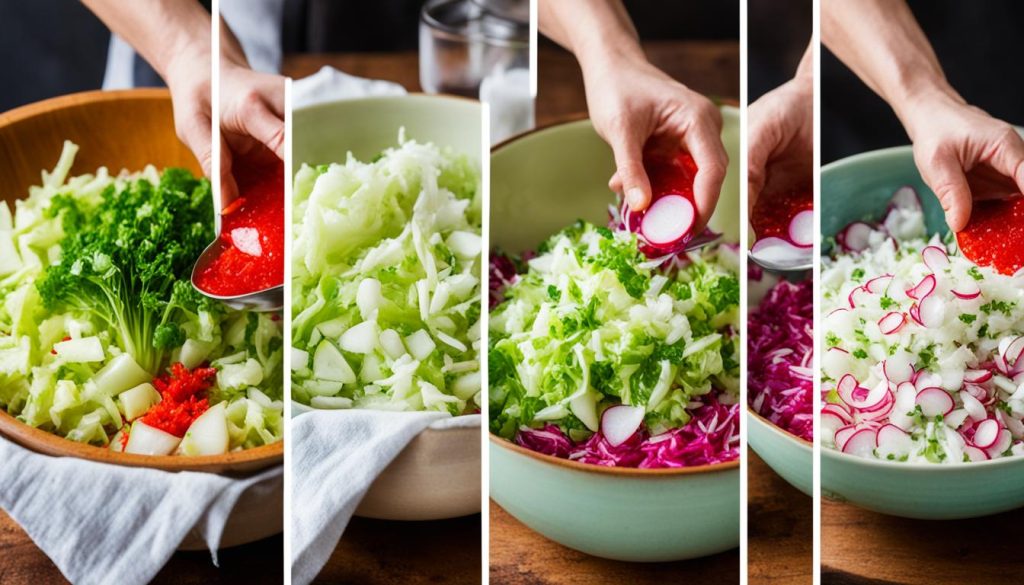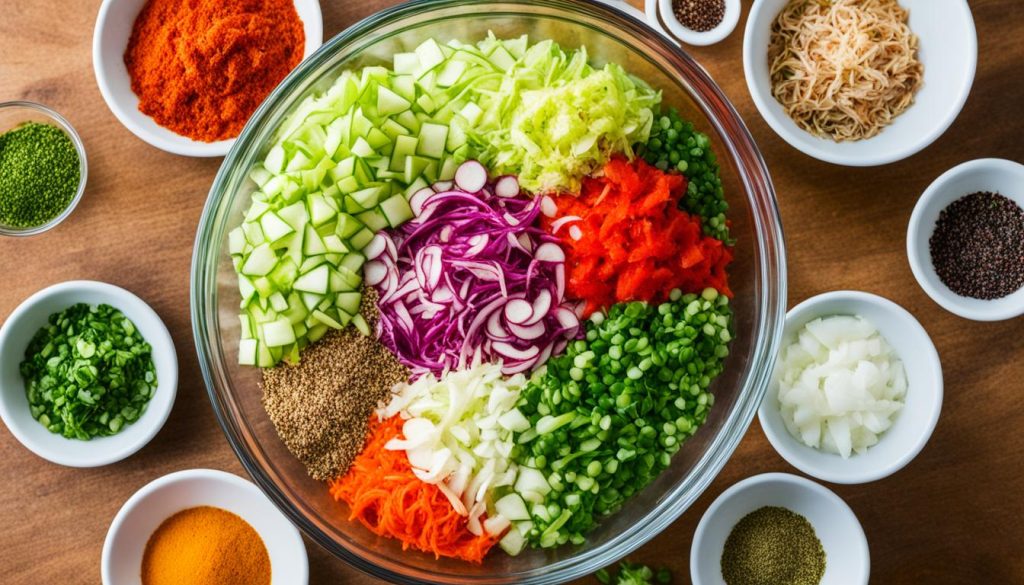
Easy Homemade Kimchi Recipe | Fresh & Tangy!
Welcome to our guide on how to make your own delicious kimchi from scratch. If you’re a fan of kimchi or new to this Korean delicacy, you’re in for a treat. We’ll take you through an easy homemade kimchi recipe that will infuse your meals with its vibrant and tangy flavors. Get ready to embark on a kimchi-making adventure!
How Is Kimchi Made?
Kimchi is a traditional Korean dish that is made through a fascinating process called kimchi-making. This process involves lacto-fermentation, which gives kimchi its distinct tangy flavor and helps to preserve the vegetables.
First, the key ingredient of kimchi, nappa cabbage, is soaked in a salty brine. This step not only helps to enhance the flavor of the cabbage but also kills any harmful bacteria that may be present.
Next, the cabbage is rinsed thoroughly to remove the excess salt and dried. It is then ready to be transformed into kimchi.
A special kimchi paste is prepared using a combination of ingredients such as garlic, ginger, sugar, salted seafood, and Korean red pepper flakes. The paste is mixed with the cabbage, ensuring that every leaf is coated with the flavorful mixture.
After the cabbage and paste are thoroughly combined, the kimchi is left to ferment in a cool place for a specific period of time. During this fermentation process, the naturally occurring Lactobacillus bacteria consume the sugars in the cabbage and convert them into lactic acid.
This lactic acid not only preserves the vegetables but also gives kimchi its tangy taste. The longer the kimchi ferments, the more complex and intense its flavors become.
Kimchi-making is similar to the fermentation processes used to create sauerkraut and traditional dill pickles. It is a wonderful way to transform humble vegetables into a delicious and probiotic-rich dish that can be enjoyed on its own or as an accompaniment to a wide range of meals.
Fun Fact:
Kimchi is so deeply ingrained in Korean culture that there is even a museum dedicated to this beloved dish! The Kimchi Museum in Seoul showcases the history and various types of kimchi, highlighting its importance in Korean cuisine.
What Ingredients Are in Kimchi?
While the exact ingredients can vary, a basic kimchi recipe typically includes napa cabbage, salt, garlic, ginger, sugar, fish sauce or shrimp paste, Korean red pepper flakes (gochugaru), and scallions. Some variations may include additional ingredients like carrots or kelp powder for added flavor. Ultimately, you can customize your kimchi recipe to suit your taste preferences.
Kimchi Ingredients:
| Ingredients | Quantities |
|---|---|
| Napa Cabbage | 1 whole cabbage |
| Salt | ¼ cup |
| Garlic | 4-6 cloves, minced |
| Ginger | 1 thumb-sized piece, grated |
| Sugar | 1 tablespoon |
| Fish Sauce or Shrimp Paste | 2 tablespoons |
| Korean Red Pepper Flakes (Gochugaru) | 2-3 tablespoons |
| Scallions | 3-4 stalks, chopped |
| Carrots (optional) | 1 small carrot, grated |
| Kelp Powder (optional) | 1 teaspoon |
Feel free to adjust the quantities of the ingredients based on your preferences. If you like it spicier, add more Korean red pepper flakes, or if you prefer it less salty, reduce the amount of fish sauce or shrimp paste. The beauty of making your own kimchi is that you have the flexibility to customize it to your liking.
Kimchi Recipe: Step-by-Step Instructions
Here is a simple step-by-step guide to making your own kimchi:
- Slice the cabbage into 2.5cm strips and mix with salt, then set aside for 1 hour.
- Make the kimchi paste by blending garlic, ginger, fish sauce (optional), chili sauce or paste, sugar, and rice vinegar.
- Rinse the cabbage, drain, and dry thoroughly.
- Toss the cabbage with the kimchi paste, along with grated radishes, grated carrots, and shredded spring onions.
- Serve immediately or pack into a large jar, seal, and let it ferment at room temperature overnight before refrigerating. The longer it ferments, the more the flavors will develop.
| Ingredients | Measurement |
|---|---|
| Cabbage | 1 large head |
| Salt | 3 tablespoons |
| Garlic | 3 cloves, minced |
| Ginger | 1 tablespoon, grated |
| Fish Sauce (optional) | 2 tablespoons |
| Chili Sauce or Paste | 2 tablespoons |
| Sugar | 1 tablespoon |
| Rice Vinegar | 1 tablespoon |
| Radishes | 2, grated |
| Carrots | 1, grated |
| Spring Onions | 3, shredded |
Tips for Making the Best Kimchi
Follow these tips to ensure your homemade kimchi turns out delicious:
- Properly brine the cabbage to remove the fresh smell and prevent softening.
- Stick to the recommended timing for pickling to achieve the desired taste and fermentation.
- Portion out the kimchi paste evenly to ensure every bite is flavorful.
- Use authentic Korean ingredients like gochugaru and Korean fish sauce for an authentic flavor, but you can make substitutions if needed.
- Consider adding additional ingredients like chives or mustard greens for extra texture, although they are not essential.

For a more visual representation, take a look at the table below:
| Tips for Making the Best Kimchi |
|---|
| Properly brine the cabbage |
| Stick to the recommended timing for pickling |
| Portion out the kimchi paste evenly |
| Use authentic Korean ingredients |
| Consider adding additional ingredients |
How to Store Kimchi
To store kimchi properly and keep it fresh, keep it in an airtight container in the refrigerator. A specialty kimchi container or a stainless steel container is recommended for optimal storage. Avoid filling the container to the brim, as the kimchi will produce gas during fermentation. The ideal storage temperature is 3-5 degrees Celsius. Kimchi can typically last in the fridge for a couple of months, but proper storage conditions can extend its shelf life up to a year.
What To Do With Kimchi
Kimchi is extremely versatile and can be used in various dishes. Here are some ideas:
- Kimchi Fried Rice: Add chopped kimchi to fried rice for a flavorful and spicy twist.
- Kimchi Jjigae: Make a hearty kimchi stew with pork, tofu, and other vegetables.
- Kimchi Pancake: Create delicious savory pancakes by mixing kimchi into the batter.
Explore more kimchi recipes online for even more creative ways to use this fermented delicacy in your cooking.

“As a kimchi enthusiast, I love experimenting with new kimchi recipes. One of my favorites is a kimchi and cheese grilled sandwich. The tanginess of the kimchi pairs perfectly with the gooey melted cheese, creating a mouthwatering combination.” – Jane Smith, Food Blogger
Conclusion
Making your own kimchi at home is easier than you might think. With this easy homemade kimchi recipe, you can enjoy the fresh and tangy flavors of this Korean staple right in your own kitchen.
Experiment with different variations and ingredients to find your perfect kimchi recipe. Customize it to suit your taste preferences, whether you prefer it extra spicy or a bit milder.
So why not embark on a kimchi-making adventure and elevate your meals with the vibrant taste of homemade kimchi? Impress your family and friends with your culinary skills and savor the delicious flavors of this beloved Korean delicacy!
FAQ
What is kimchi?
Kimchi is a traditional Korean dish made through a process called lacto-fermentation. It is typically made with napa cabbage, salt, garlic, ginger, sugar, fish sauce or shrimp paste, Korean red pepper flakes (gochugaru), and scallions.
How is kimchi made?
Kimchi is made by soaking napa cabbage in a salty brine to kill harmful bacteria. Then, good bacteria called Lactobacillus convert sugars into lactic acid, preserving the vegetables and creating the tangy flavor of kimchi.
What ingredients are in kimchi?
The basic kimchi recipe includes napa cabbage, salt, garlic, ginger, sugar, fish sauce or shrimp paste, Korean red pepper flakes (gochugaru), and scallions. Additional ingredients like carrots or kelp powder can be added for extra flavor.
How do you make homemade kimchi?
Here is a simple step-by-step guide to making homemade kimchi:
1. Slice the cabbage into strips and mix with salt.
2. Make the kimchi paste by blending garlic, ginger, fish sauce (optional), chili sauce or paste, sugar, and rice vinegar.
3. Rinse the cabbage, drain, and dry thoroughly.
4. Toss the cabbage with the kimchi paste, along with grated radishes, grated carrots, and shredded spring onions.
5. Serve immediately or let it ferment at room temperature overnight before refrigerating.
Any tips for making the best kimchi?
Yes! Here are some tips for making the best kimchi:
1. Properly brine the cabbage to remove the fresh smell and prevent softening.
2. Stick to the recommended timing for pickling to achieve the desired taste and fermentation.
3. Portion out the kimchi paste evenly to ensure every bite is flavorful.
4. Use authentic Korean ingredients like gochugaru and Korean fish sauce for an authentic flavor.
5. Consider adding additional ingredients like chives or mustard greens for extra texture.
How do you store kimchi?
To store kimchi properly and keep it fresh, keep it in an airtight container in the refrigerator at a temperature of 3-5 degrees Celsius. Avoid filling the container to the brim, as the kimchi will produce gas during fermentation. Kimchi can typically last in the fridge for a couple of months, but proper storage conditions can extend its shelf life up to a year.
What can I make with kimchi?
Kimchi is extremely versatile and can be used in various dishes. Some ideas include kimchi fried rice, kimchi jjigae (stew), kimchi pancakes, and more. Explore more kimchi recipes online for even more creative ways to use this fermented delicacy in your cooking.
Can I make vegan kimchi?
Yes, you can make vegan kimchi by omitting the fish sauce or shrimp paste and substituting it with a vegan alternative like soy sauce or miso paste.
How long does homemade kimchi last?
Homemade kimchi can typically last in the refrigerator for a couple of months, but proper storage conditions can extend its shelf life up to a year.

